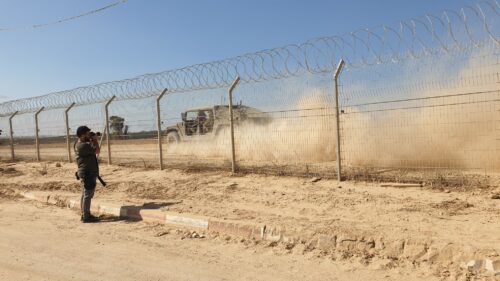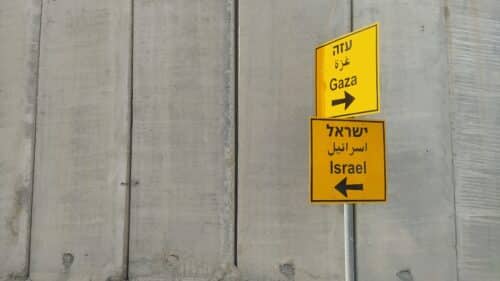A common game among toddlers around the world is “Baby’s First Blocks”, in which the toddler tries to insert various shapes into a box through openings designated for that shape. What happens when the toddler attempts to insert a square cube into a triangular opening? He understands that he must change strategy, reconsider the way to solve the problem before him – and try again.
Surprisingly, when it comes to resolving the Israeli-Palestinian Conflict, Israel repeatedly tries to insert a cube into a triangular opening: attempting the “two states for two peoples solution” and experiencing its incompatibility anew every time, as if there are no other solutions that could better fit the problem.
We believe otherwise. There are other, viable solutions that could lead to prosperity and growth throughout the region. We do not pretend to present the Israeli-Palestinian issue in a simplistic light, and it is not our intention to create spins that ignore the “tough nuts” to crack on issues of religion, narratives, demographics and citizenship. However, there is need for fresh thinking that sees before it the wall of the Israeli-Palestinian Conflict and attempts to cross it in creative ways, rather than slamming the square cube into a triangular opening.
Between “Managing” and “Ending”: The Two-State Solution
The discourse for resolving the Israeli- Palestinian conflict in the internal Israeli discourse primarily focuses upon managing the conflict, without a long-term strategic purpose that could constitute a compass for possible directions of action that would lead to ending the conflict. At the same time, a significant portion of the international discourse focuses upon criticizing the policy that Israel operates under in Judea, Samaria and the Gaza Strip.
The two-state solution has therefore become the dominant pattern of thinking, and has indirectly helped in fixing a series of concepts, the most astounding of which claims that the Israeli- Palestinian conflict began in 1967 and does not derive from two contradictory religious and national narratives pertaining to the same land. The two-state solution has also contributed to the distorted idea that the Jewish people are a foreign occupier in their historical homeland, merely because of that Jordanian occupation that lasted 19 years, which hardly any country had recognized.
This narrow perspective of the conflict has yet to lead to any results, and has inflicted great damage up on both sides, primarily due to a lack of thinking on the red lines that are so clear: the State of Israel cannot accept a withdrawal to borders that are not defensible or abandon the holy sites in Jerusalem and the “Bible Belt” in Judea and Samaria. It also has no reason to do so.
1. Israel as the eternal homeland of the Jewish people: The basic assumption is that the Land of Israel, including Judea and Samaria and the holy sites, is the historical and eternal homeland of the Jewish people, a place that is inseparable from the Jewish identity as a religion and
a nation.
2. Striving towards a practicable settlement: Recognition of the practical need to strive towards a practicable settlement vis-à-vis the Palestinians, in order to enable them to govern their civil affairs. An arrangement of this type shall be a direct continuation of the route that has already been agreed to, prepared and executed within the framework of the Oslo Agreements, which are still currently in effect. It provided the Palestinians full civil control over their population centers, presenting a vision of a demilitarized Palestinian entity alongside the Jewish and democratic State of Israel.
3. Permanent borders: The basic assumption is that Israel shall only rely upon itself and defend itself on its own, and cannot afford to rely upon foreign or international military forces in order to ensure its existence. For this purpose, the permanent borders of Israel after any political settlement must be defensible and viable.
- Jerusalem shall remain the unified capital of the State of Israel. Various arrangements can be found for those periphery communities beyond the separation fence, which are still considered at present to be part of the city.
- Israel shall apply full sovereignty over the Jordan Valley in the broadest meaning, in a manner that ensures a defensible eastern border vis-à-vis threats such as Iran and regional instability.
- Israel shall maintain full security and military control over Judea and Samaria, based upon strong Jewish settlements along key routes and areas and at locations that are important to the Jewish people as a force multiplier. The Israeli security control shall also include the electromagnetic space, the airspace and border control.
4. Encouraging prosperity: Although Israel is not responsible for the welfare of the Palestinians, it should encourage the empowerment of the local population, erect joint industrial zones, promote an economic peace and enable regular daily life for the benefit of all parties.
The principles above go far beyond the technical security arrangements that may be met in another way, as was proposed in plans such as the Alan Plan. The central working assumption of Israel is that it would always rely only upon itself and defend itself on its own, and that it cannot afford to rely upon foreign or international military forces in order to ensure its existence. Moreover, these points are not a vision that has only been adopted by the national camp in Israel, but also constitute a consensus that was adopted by the Rabin Government as the foundation of the Oslo Agreements.
Better Solutions Than the Two States: A Reservoir of Alternative Plans
The plans that we specify below are intended to create applicable alternatives vis-à-vis various scenarios that may be created in the near and distant future. We are not recommending any specific plan, but rather encourage a debate on solutions that are more applicable than two states for two peoples.
- The Palestinian Emirates Plan: The only loyalty in the Middle East is to one’s family, religion and tribe, rather than to artificial nation states. Accordingly, this plan is based upon the recognition of the tribe-clan disbursement of the Palestinian population, which is not monolithic. There are very few ties and very little trust between the various clans in Jenin, Bethlehem, Ramallah and Nablus. The western-colonialist attempt to impose the Westphalian nation state model upon the region has failed miserably. Therefore, we should establish eight Emirates throughout Judea, Samaria and Gaza, which are based upon city-states under the control of the local clans.
- The Palestinian-Jordanian Confederacy: 70%-80% of the citizens of Jordan are Palestinian. In the event the Jordanian royal family collapses, it would be reasonable to establish a Palestinian state instead of today’s Kingdom of Jordan, with enclaves in Palestinian population centers in Judea and Samaria, or alternatively, to establish a confederacy or a joint Jordanian-Palestinian federation between the Kingdom of Jordan and the enclaves in Judea and Samaria. Thus, the national aspirations of the Palestinians will be met in the form of the establishment of a Palestinian state in conjunction with Jordan.
- The new state solution in the Gaza Strip: The new state plan remains faithful to the international position that promotes negotiations towards two states, one Israeli and one Palestinian, living side-by-side in peace and security, and would satisfy Palestinian national aspirations. Therefore, we must establish an independent and sovereign Palestinian state alongside the State of Israel in the Gaza Strip, with territorial contiguity into the northern Sinai region.
- The deal of the century: A realistic two-state solution in which a safe and prosperous Palestine exists in peace alongside a safe and prosperous State of Israel within a safe and prosperous region. This is a holistic and security-focused vision, which provides self-determination to the Palestinians, security to Israel, and significant economic opportunities for both parties and for countries in the region. The State of Palestine shall be completely demilitarized and shall remain so. In addition, Israel shall agree to significant territorial concessions in order to enable the Palestinians to have a viable state. Territorial swaps shall provide the State of Palestine an area roughly equal to that of Judea, Samaria and Gaza on the eve of the Six-Day War in 1967. The Jordan valley, which plays a critical role in Israel’s security, shall remain under Israeli sovereignty.
It is time to leave behind the failed outline of “two states for two peoples” in its current form and move on to new ideas, while moving the spotlight of the discourse to alternative solutions to end the conflict. It is quite possible that the Israeli-Palestinian question shall be in an entirely different place if only Israel moves from paralysis to initiative and strives towards maximum utilization of the many opportunities that are already available.
“The purpose of the position paper is to create order”, said Or Yissachar, the Head of the Research Department of the IDSF. “We present all the alternatives to the two-state solution, with their advantages and disadvantages, in a concentrated and unprecedented fashion. ‘Reimagining an old conflict’ presents a vision that is separate from the current two-state vision. The position paper presents the central pillars upon which the Government of Israel must place any future political settlement concerning Judea and Samaria and the Jordan Valley. These central pillars are essential for the continued preservation of the security of the State of Israel. Therefore, the IDSF is not adopting a single settlement as the sole solution for the conflict, but rather presenting various plans whose execution is contingent upon their meeting the various central pillars that are critical to the security of Israel.”





